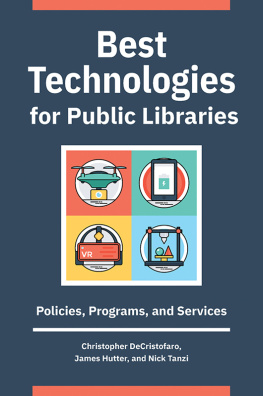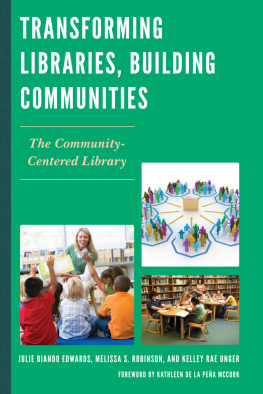Kay Ann Cassell is an adjunct professor at the Rutgers University Department of Library and Information Science where she teaches a variety of courses, including reference and information services, collection development, and public libraries. She has worked in public and academic libraries. She has been the director of the Bethlehem (New York) Public Library, the director of the Huntington (New York) Public Library, the director of the New School for Social Research library, and the associate director for collections and services at the New York Public Library (NYPL). As NYPLs associate director of collections and services, she oversaw the development of reference services, collections, programs, and services for all branches. She has also worked as a coordinator for public library services at the New Jersey State Library and the Westchester Library System. Cassell is the coauthor of Reference and Information Services: An Introduction and the author of Managing Reference Today.
I n the United States, public libraries serve their communities by providing free educational resources and meeting spaces, a variety of physical and digital materials, equipment, internet access, and access to informational professionals who provide programs [for all ages] and answer questions for their patrons (Institute of Museum and Library Services [IMLS] 2020, vii). By offering access to collections, technology and community spaces, public libraries enhance civic life and provide valuable access points to various information resources that some may not normally be able to access (IMLS 2020). Public libraries are today an integral part of American life. The characteristics of a public library are that it is maintained by a local government, supported by tax dollars, and open and free to all. There are, of course, many models for public libraries. They can be a municipal library, a school district library, a county library, or an independent library. Some are smallone roomor large with many rooms and many floors. Some are mobile unitsa bookmobile or a boat. Most communities in the United States have a public library. There are approximately 9,045 active public libraries in the United States with 16,735 central and branch libraries and 619 bookmobiles (IMLS 2020). The IMLS report also states that in 2017, there was an average of 4.2 visits per capita, and for every 1,000 people in a librarys service area, 378.7 attended a program (IMLS 2020). Public libraries are emphasizing their work with people and their outreach into the communities and expanding their programs and services to meet the needs of their communities. Circulation averaged 7.3 per capita with increased use of e-books and audio. Public library collections have continued to grow. The Pew Research Center survey states that
public attitudes are largely positive about the librarys role in communities. Many Americans are interested in libraries offering a range of servicesincluding those that help people improve their digital skills and learn how to determine what information is trustworthy. People think that libraries are a major contributor to their communities in providing a safe place to spend time, creating educational opportunities for people of all ages, and sparking creativity among young people. (Horrigan 2016)
As indicated by the Pew survey, most people in a community support public libraries even if they are not frequent users of the public library. Public libraries are used by the public for information, education, and recreation. As can be seen from the history of public libraries, the development of public libraries was a grassroots effort. Communities wanted a library free and open to all. Libraries that charged a fee were not considered acceptable in this new country with its democratic principles.
As soon as people began to settle in the United States they wanted books. Wealthy people ordered books from England and set up their own private libraries. Less than a decade after the Pilgrims landed at Plymouth Rock, John Endicotts pioneer settlement at Salem received a collection of books that evidently were intended for community use (Shera 1949, 245). By the middle of the eighteenth century, libraries were already in operation. The first libraries were parish libraries and town book collections. In 1731, Benjamin Franklin organized the Library Company of Philadelphia. It was a social library where people could contribute money to be used to purchase books and then have a membership to use the library. Social libraries often had space in the building for public lectures as well. Many more social libraries sprang up first in Connecticut and Rhode Island and then elsewhere in New England. Even before the American Revolution, New England had more than fifty social libraries (Wiegand 2015, 9). A notable one was the Redwood Library in Newport, Rhode Island, that received money for the collection from Abraham Redwood in 1747 and moved into its own building in 1750. The model for the social library had come from England.
Early libraries collected books that contained what they called useful knowledge. Fiction was controversial, and social libraries tended not to acquire fiction. Therefore, circulating libraries that made books available for a rental fee or a membership fee grew up that provided fiction for borrowers. Circulating libraries were often connected to businesses such as bookstores, coffeehouses, or a store frequented by women since they were usually the best customers. The social libraries continued to develop in New England in the 1750s and 1760s, and more were formed after the revolution. Legislation passed in the states made it easier to charter a social library. Social libraries spread to the West as it was settled. They eventually became public libraries, free and open to the public and supported by the municipality since the social libraries were not well funded and could not provide enough books for a public wanting a wide variety of works. It was recognized that the public libraries provided not only knowledge but also a place where people could meet and talk about the books they were reading. As a result, the public library and the lyceum movement, offering lectures and courses, were often coupled together.
Other models of early libraries were mercantile libraries, proprietary libraries, and subscription libraries. Young men wanting to improve themselves established the mercantile libraries, where there were book collections as well as classes and lectures. Two of the early ones were established in Boston and New York. The proprietary libraries tended to appeal more to the wealthy and were based on the purchase of shares of stock that could be transferred to someone else by sale or by gift or bequest. The subscription libraries were more democratic and were based on the idea of people being able to use the library if they purchased an annual subscription.
Boston was the early center of bookselling at the end of the seventeenth century. By 1720, there were five printing presses in Boston and many bookstores (Shera 1949, 46). The Boston Athenaeum opened in 1807 and sold stock to those who wanted to join. It also offered members lyceum series with lectures and courses. The first library supported by local taxes was the Peterborough (New Hampshire) Town Library established in 1833. The first legislation for cities and towns to maintain free libraries by taxation was passed in New Hampshire in 1849 and in Massachusetts in 1851. In 1847, the mayor of Boston anonymously offered the city $5,000 if the city council would authorize a tax to establish and maintain a public library. This plan was approved in 1848 (Wiegand 2015, 2526). Harvard professors George Ticknor and Edward Everett were responsible for drawing up the operating plans for the Boston Public Library. Their forward thinking set a model used by future public libraries. They recommended free admission to all, the circulation of books for home use, and the acquisition of multiple copies of a wide range of reading materials from scholarly to popular. Although there would continue to be a great deal of controversy about whether public libraries should collect and circulate fiction, Boston Public Library led the way by buying and circulating the popular literature of the day. By doing this they were accomplishing Ticknors goal of educating the lower classes. The first Boston Public Library reading room was established in 1854, in a schoolhouse, and the new building was opened in 1858. The new Boston Public Library was administered by the Board of Trustees who were given the power to control all expenditures of library funds, appoint all officers including the librarian, and fix their compensations (Shera 1949, 156).










